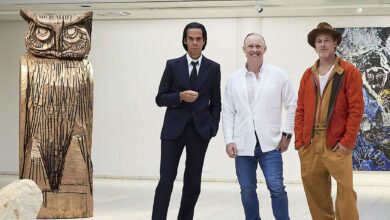An exhibition recovers 31 invisible women artists
The nun Paulina Buxó and Mey Rahola are two pioneers of photography

L’Empordà is a land of artists, and not only because of Salvador Dalí and the endless list of painters who have passed through Cadaqués, but there are hardly any names of women on the list. And in the process of recovering invisible artists, there is now an exhibition at the Museu de l’Empordà in Figueres that shows the almost unknown work of 31 creators, born between 1830 and 1939 and linked at some point with the region.
Thanks to the almost detective work of the commissioner Cristina Masanés, it has been possible to remove from oblivion women who never dared to expose, others who only worked until they got married and who did not even dare to sign with their own name. All were generally criticized by men who saw in his production “an endearing feminine delicacy” or “a tender and charming emotion”. Even the most renowned suffered from these prejudices. Juan-Eduardo Cirlot refers to Elena Paredes pointing out that “the eternal feminine appears in some of her paintings.” And the Ràfols dictionary catalogs the production of Caterina Albert –who as a writer signed with the pseudonym Victor Català– “within the most genuine current of naive art”.
Another of the recovered artists, Magda Folch, the first woman to occupy a teaching position at the Figueres institute, responded to the journalist Manuel del Arco, who had referred to her feminine condition, with this emphaticness: either it is done well or it is done badly. And that has been the criterion that has guided the selection of works, but not the only one. “In the way we explain or reproduce it, we have tried to offer a feminist perspective,” explains Cristina Masanés.
Most of these 31 women belong to the middle or upper classes, some were able to attend classes, others were able to create protections for their families or had their own space. In 1919 Virginia Wolf wrote that “intellectual freedom depends on material circumstances” and claimed a room of one’s own and 500 pounds of income as the minimum essential to create with conditions. Caterina Albert talks about the “little nest” in the attic of her house in L’Escala. Mercè Huerta, married to the journalist Narcís-Jordi Aragó, said that she had “her own room, upstairs,” and Elena Paredes had the island of S’Arenella, in Cadaqués, bought by her husband, the industrialist Jorge Rivière.
In several of these artists at the end “life passes before creation” and marriage and children or the public projection of their husbands ended up making them invisible. The exhibition even reflects gender conditioning on the subject. Nudity does not appear in these works, and the figure of man hardly. One reason is that there were no men to act as models. And instead there are many references to the domestic space. Many women appear, also children. Drawing abounds and there is hardly any sculptural work.
The exhibition is divided into several sections, with a very effective montage by the designer Pep Canaleta, and a documented catalog that includes 31 mini-biographies, with unpublished information that points to other individualized studies in the future. The most striking case is that of Mey Rahola de Falgàs, claimed as a Catalan pioneer of artistic photography of the 1930s. Although she was born in León and studied in Madrid, she spent her holidays in Cadaqués, where she met her husband, Josep Xirau Palau, deputy in the Cortes of 1931. The civil war cut short their career and they went into exile. In Arcachon they coincided with the President of the Republic Manuel Azaña, of whom he took one of the last photos, which is exhibited in Figueres. And although she worked as a commercial photographer, she no longer participated in any exhibitions. Your great-grandson has undertaken recovery work that could culminate in an exhibition at the MNAC.
Among the well-known names is Ángeles Santos Torroella, who was already triumphing at 18, but whom the weight of the family and then her husband, the painter Emili Grau Sala, ended up overshadowing. The exhibition also includes Gala, as a muse and creator, but above all as a promoter of Paul Éluard and Salvador Dalí. And to Àntonia Gironès Bofill, who dedicated her life to protecting and supporting her artist children: Ramon, Niní, Lluís and Ricard Pichot, who triumphed in the pictorial and musical fields.


